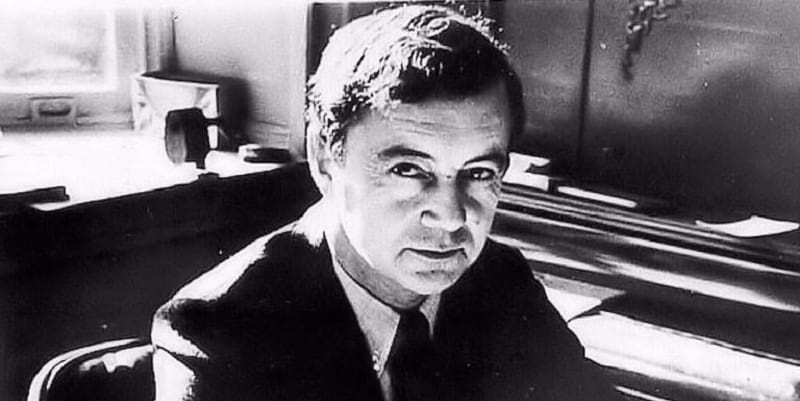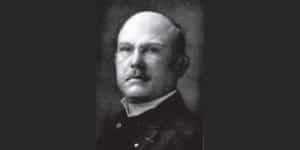Erving Goffman biography and theory

Erving Goffman (1922 – 1982) was a Canadian-American sociologist, writer and social psychologist. Erving Goffman is known for his strong influence on American sociology of the twentieth century. This article discusses Goffman’s theory, what he is known for and his biography. It also contains quotes and publications.
In ‘The Presentation of Self in Everyday Life’ (1959), Goffman sketched the dramaturgical perspective he would also use in next studies such as Asylums (1961). He mainly conducted research into personal communication and rituals of social interaction. In ‘Forms of Talk’, he particularly focused on the way people define the social reality in the communicative process. This is also referred to as interactism.
His developments were influenced by the greats in sociological circles, of whom Everett Hughes is considered the person who influenced Erving’s vision the most.
The biography of Erving Goffman
Erving Goffman’s early life
Erving Goffman was born on 11 June 1922 in Alberta, Canada. His parents were Max and Anne Goffman, Ukrainian Jews who had immigrated to Canada just before he was born. Around the time that Goffman was to attend secondary school, his parents moved to Manitoba.
Goffman went to the St. John’s Technical High School in Winnipeg, and later studied chemistry at the University of Manitoba in 1939. After a few years, Goffman decided to transfer to sociology and completed his BA in 1945.
After successfully completing his first university degree, Erving Goffman enrolled in a graduate school and completed a doctorate in sociology in 1953. Trained in the tradition of the Chicago School of Sociology, he conducted ethnographic research and particularly studied the symbolic interaction theory.
He later revealed that Sigmund Freud, Talcott Parsons, Georg Simmel and Herbert Blumer greatly influenced his work.
For his dissertation, he studied everyday social interaction and rituals on Unset. Unset is an island between the Shetland islands off the coast of Scotland.
In 1952, Goffman married Angelica Choate. Together, they had a son, Thomas. Angelica committed suicide in 1964, brought on by a psychological disorder.
Erving Goffman’s career
After completing his doctorate and after marrying, Goffman accepted a job at the National Institute for Mental Health in Bethesda.
Here, he conducted participant observation research that would eventually become the basis for his second book: ‘Asylums: Essays on the Social Situation of Mental Patients and Other Inmates’. This book was published in 1961 and addresses how the process of institutionalisation socialises people in the role of a good patient.
Goffman’s first book, ‘The Presentation of Self in Everyday Life’, in 1959 is perhaps his most famous work. Based on the previously mentioned study in Scotland, Goffman discussed his dramaturgical approach for studying the details of everyday personal interaction and impression management in this book.
He used imagery from the theatre to depict the importance of human and social interaction. All actions, so he argued, are social presentations that serve a specific goal, namely to give and maintain the desired impressions.
Furthermore, he explains that social interactions include actors, people, at a stage who perform in front of an audience. The only time individuals can be themselves, and thus lose their role, is in the absence of an audience. This is true for everyone who is part of a society.
From 1958, Erving Goffman occupied a faculty position in the sociology department at the university of California – Berkeley. In 1962, he was promoted to professor. In 1968, he was appointed to the Benjamin Franklin Chair in Sociology and Anthropology at the University of Pennsylvania.
Goffman’s findings during his last major study were published in ‘Goffman’s Frame Analysis: An Essay on the Organization of Experience’. This book was published in 1974. Frame analysis is the study of the organisation of certain social experiences.
In his book, Goffman wrote about how conceptual frames can structure an individual’s perception. To illustrate this concept, Erving Goffman used the concept of a picture frame. The frame, so he said, represents structure and is used to keep the context of an individual in tact, represented by a photograph.
When Goffman studied the symbolic interaction method, he began to view the men and women in the world as part of a drama. In that drama, men and women play a specific role.
Personal life and final years
After his first marriage, which gave him a son, Erving Goffman got remarried to Gillian Sankoff in 1981. Gillian was a sociolinguist. Together, they had a daughter, Alice. She was born in 1982.
In that same year, Goffman died of stomach cancer. His daughter Alice Goffman became a remarkable sociologist in her own right.
Criticism
Although Erving Goffman had many followers in sociology, his work was also criticised. He broke nearly all rules of conventional methodology. His sources were often unclear, his fieldwork seemed minimal and he was more interested in novels and biographies. His style was not the style of a usual scientific report, and his work method was very unsystematic.
Additionally, he was constantly accused of ignoring the wider macro-social aspects of his studies, such as social structure, classes and economies. On this subject, he said that these weren’t just his concerns, but that these were more important than mere ‘concerns’. Others have accused him of conservatism, because he often emphasised the importance of order and ritual, sex and maintaining aspects such as the status quo.
Erving Goffman quotes
- “Approved attributes and their relation to face make every man his own jailer; this is a fundamental social constraint even though each man may like his cell.”
- “And to the degree that the individual maintains a show before others that he himself does not believe, he can come to experience a special kind of alienation from self and a special kind of wariness of others.”
- “We are all just actors trying to control and manage our public image, we act based on how others might see us.”
- “Perhaps the individual is so viable a god because he can actually understand the ceremonial significance of the way he is treated, and quite on his own can respond dramatically to what is proffered him. In contacts between such deities there is no need for middlemen; each of these gods is able to serve as his own priest.”
- “Gender, not religion, is the opiate of the masses.”
- “In reviewing his own moral career, the stigmatized individual may single out and retrospectively elaborate experiences which serve for him to account for his coming to the beliefs and practices that he now has regarding his own kind and normals.”
- “The act of staring is a thing which one does not ordinarily do to another human being; it seems to put the object stared at in a class apart. One does not talk to a monkey in a zoo, or to a freak in a sideshow— one only stares.”
- “the model of “social order.” Briefly, a social order may be defined as the consequence of any set of moral norms that regulates the way in which persons pursue objectives.”
- “Choose your self-presentations carefully, for what starts out as a mask may become your face. ”
- “The self… is not an organic thing that has a specific location, whose fundamental fate is to be born, to mature, to die; it is a dramatic effect arising diffusely from a scene that is presented. ”
- “The normal and the stigmatized are not persons, but perspectives. ”
- “Society is organized on the principle that any individual who possesses certain social characteristics has a moral right to expect that others will value and treat him in an appropriate way. ”
- “All the world is not, of course, a stage, but the crucial ways in which it isn’t are not easy to specify. ”
- “Society is an insane asylum ran by the inmates. ”
- “Stigma is a process by which the reaction of others spoils normal identity. ”
- “And to the degree that the individual maintains a show before others that he himself does not believe, he can come to experience a special kind of alienation from self and a special kind of wariness of others. “
- “Approved attributes and their relation to face make every man his own jailer; this is a fundamental social constraint even though each man may like his cell. “
- “The world, in truth, is a wedding. “
- “Man is not like other animals in the ways that are really significant: Animals have instincts, we have taxes. “
- “When persons are present to one another they can function not merely as physical instruments but also as communicative ones. This possibility, no less than the physical one, is fateful for everyone concerned and in every society appears to come under strict normative regulation, giving rise to a kind of communication traffic order. “
Publicaties and books by Erving Goffman et al.
- 2009. Relations in public. Transaction Publishers.
- 2009, 2003. Stigma. Praha: Sociologické nakladatelství (SLON).
- 2008. Behavior in public places. Simon and Schuster.
- 2006. Where the action is. The sociology of risk and gambling reader, 225-254.
- 2005. Interaction ritual: Essays in face to face behavior. AldineTransaction.
- 2002. The presentation of self in everyday life. 1959. Garden City, NY, 259.
- 2001, 1989. On fieldwork. Journal of contemporary ethnography, 18(2), 123-132.
- 1983. Felicity’s condition. American journal of sociology, 89(1), 1-53.
- 1983. The interaction order: American Sociological Association, 1982 presidential address. American sociological review, 48(1), 1-17.
- 1981. A reply to Denzin and Keller.
- 1981. Forms of talk. University of Pennsylvania Press.
- 1979. Footing. Semiotica, 25(1-2), 1-30.
- 1979. Gender advertisements. Macmillan International Higher Education.
- 1978. Response cries. Language, 787-815.
- 1977. The arrangement between the sexes. Theory and society, 4(3), 301-331.
- 1976. Gender display. In Gender advertisements (pp. 1-9). Palgrave, London.
- 1975. Role-distance. Life as Theater: A dramaturgical sourcebook, 123-132.
- 1970. Strategic interaction (Vol. 1). University of Pennsylvania Press.
- 1969. The insanity of place. Psychiatry, 32(4), 357-388.
- 1968. Asylums: Essays on the social situation of mental patients and other inmates. AldineTransaction.
- 1967. On face-work. Interaction ritual, 5-45.
- 1964. The neglected situation. American anthropologist, 66(6), 133-136.
- 1961. Encounters: Two studies in the sociology of interaction. Ravenio Books.
- 1959. The Presentation of Self in Everyday Life. Doubleday: New York, NY, USA.
- 1959. The moral career of the mental patient. Psychiatry, 22(2), 123-142.
- 1958. Characteristics of total institutions. In Symposium on preventive and social psychiatry (pp. 43-84). US Government Printing Office.
- 1957. Alienation from interaction. Human relations, 10(1), 47-60.
- 1956. Embarrassment and social organization. American Journal of sociology, 62(3), 264-271.
- 1956. The nature of deference and demeanor. American Anthropologist, 58(3), 473-502.
- 1955. On face-work: An analysis of ritual elements in social interaction. Psychiatry, 18(3), 213-231.
- 1952. On cooling the mark out: Some aspects of adaptation to failure. Psychiatry, 15(4), 451-463.
- 1951. Symbols of class status. The British journal of sociology, 2(4), 294-304.
How to cite this article:
Janse, B. (2020). Erving Goffman. Retrieved [insert date] from Toolshero: https://www.toolshero.com/toolsheroes/erving-goffman/
Original publication date: 07/07/2020 | Last update: 09/08/2023
Add a link to this page on your website:
<a href=”https://www.toolshero.com/toolsheroes/erving-goffman/”>Toolshero: Erving Goffman</a>











